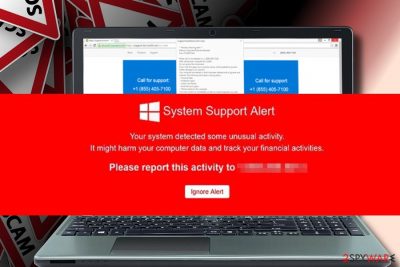System Support Alert (Support Scam Virus) - updated Sep 2018
System Support Alert Removal Guide
What is System Support Alert?
System Support Alert is a fake alert that uses compromised websites to convince users that their personal information is in danger

System Support Alert is a fake message that belongs to Technical Support Scam category.[1] It has been spotted attacking users at the end of March 2018 striking people who try to access websites like Amazando.co, Free3dadultgames.com, Onclickrev.com, and, most recently, WordPress.org. The pop-up reports an Error # 0x80072ee7 warns users about the “suspicious activity” that can cause money or sensitive information loss. The System Support Alert then prompts victims to contact the alleged Tech Support to prevent the damage. Although the pop-up window mimics Microsoft design, coloring, and marking, Microsoft does not distribute such warning, especially with telephone number provided.
| Name | System Support Alert |
|---|---|
| Malware type | PUP, Technical Support Scam |
| Main symptoms | Web browser initiates redirects and freezes with a pop-up alert showing Error # 0x80072ee7 and saying “System Support Alert” |
| Contact info | 1-855-205-8314 (may vary). The number belongs to criminals, so do not call for it |
| Affected web browsers | Google Chrome, Mozilla Firefox, Internet Explorer, Microsoft Edge, Safari, Opera, and others |
| Download FortectIntego to repair damage done bu pups | |
System Support Alert is not an ordinary Microsoft alert. It's a scam developed by cybercriminals who seek to earn money in illegal ways. They trick less tech-savvy people into believing that their PCs are at risk. Criminals are great psychologists that render various strategies to fool people.
First of all, they impersonate legitimate companies, such as Microsoft. To look more convincing, they misuse numeric codes, as in this case Error # 0x80072ee7″[2]. Besides, they induce the act of immediacy by employing JavaScrip code, which freezes the web browser, and urges to call for “certified technicians” for help.
Usually, the System Support Alert scam occurs in several layers. When trying to access a hacked website, web browser (Google Chrome, Mozilla Firefox, Internet Explorer, Microsoft Edge, Safari, etc.) initiates multiple redirects and eventually stops at a website saying:
** System Warning Alert **
Malicious Spyware/Riskware Detected
Error # 0x80072ee7
Please call us immediately at 1-855-205-8314
Do not ignore this critical alert.
If you close this page, your computer access will be disabled to prevent further damage to our network.
Your computer has alerted us that it has been infected with a Pornographic Spyware and riskware.
The following information is being stolen…
Financial Data, Facebook Logins, Credit Card Details, Email Account Logins, Photos stored on this computer
You must contact us immediately so that our expert engineers can walk you through the removal process over the phone to protect your identity.
Please call us within the next 5 minutes to prevent your computer from being disabled or from any information loss.
Toll-Free: 1-855-205-8314
Right after the above given pop-up window, the System Support Alert tech-support-scam generates a pop-up notification in a red background saying:
System Support Alert
Your system detected some unusual activity.
It might harm your computer data and track your financial activities.
Please report this activity to 1-855-205-8313
Please, do not fall for calling. At best, the indicated telephone number may be premium-rate and the first minute may charge more than $2.99. In this case, criminals may try to stretch the time to make you pay as much as possible.

Unfortunately, hackers on the other side of the handset may try to extort personal information out of you or trick into downloading Remote Desktop applications, so that they could connect to your PC remotely and take over of the system.
In most of the cases, this fake pop-up shows up on people's web browsers soon after they download a potentially unwanted program (PUP), such as adware or browser hijacker. PUP can further initiate redirects to hacked websites. Thus, to remove System Support Alert scam, you should check your PC for unwanted programs and eliminate each of them. You should use security software or eliminate each threat manually. To fix your computer after PUP infection, scan it with FortectIntego.
Don't worry about PUP removal did not stop intrusive pop-ups from occurring. System Support Alert removal will be finished when you reset your web browser's default settings. You can learn how to do that following the guide given at the end of this post.
A popular content management system WordPress compromised – hackers inject scam messages
According to researchers,[3] content management system (CMS), WordPress has been compromised and is redirecting users to the System Support Alert and other scams since early September. Therefore, thousands of website owners who host their sites on this domains fell victims to the ordeal.
Experts explained that this campaign allowed crooks to use vulnerable systems (which use outdated plugins) to inject malicious JavaScript that leads to domains like ads.voipnewswire.net or similar. Unfortunately, these sites are not safe and might result in malware infections such as CoinHive crypto-mining malware, as well as loss of money and data due to tech support scams.
WordPress is not the only platform that has been affected by similar incidents. Dubbed Drupalgeddon, Drupal vulnerabilities led to ransomware infections on even governmental sites. Therefore, owners of vulnerable domains are urged to clean out the infected pages and update to the latest version of WordPress software.

Tech-support-scam is usually triggered by adware
The research initiated by utanvirus.us[4] team proved the fact that Technical-Support-Scam alerts are usually displayed by hacked websites. However, people seldom stumble upon those websites accidentally. Their web browser is purposely redirected to infected sites by potentially unwanted programs, such as adware or browser hijacker.
If you have never dealt with a PUP, you should beware that they are usually spread via software packages in the form of web browser add-ons and toolbars. That's why they tend to infiltrate PCs without being noticed.
To protect yourself from unwanted installers, be cautious during the installation of any free program, be it a download manager or converter. Select Advanced or Custom installation method all the time and remove ticks saying that you agree with the installation of toolbars, extensions or other additional components.
Get rid of System Support Alert Scam
System Support Alert removal consists of two phases. First of all, you should eliminate a PUP that slithered to your PC via software stack.
Alternatively, you can remove System Support Alert manually. Open Control Panel and investigate what kind of apps have recently been installed on your PC. Eliminate all suspicious apps that you did not remember installing.
The second phase requires the recovery of your web browser. To stop intrusive scam alerts, you should disable malicious Chrome extensions. You can find a tutorial on how to disable System Support Alert virus on Chrome and other web browsers down below.
You may remove virus damage with a help of FortectIntego. SpyHunter 5Combo Cleaner and Malwarebytes are recommended to detect potentially unwanted programs and viruses with all their files and registry entries that are related to them.
Getting rid of System Support Alert. Follow these steps
Uninstall from Windows
To terminate malicious scam alert, you should delete PUPs from the system in the first place. For that, please follow this guide:
Instructions for Windows 10/8 machines:
- Enter Control Panel into Windows search box and hit Enter or click on the search result.
- Under Programs, select Uninstall a program.

- From the list, find the entry of the suspicious program.
- Right-click on the application and select Uninstall.
- If User Account Control shows up, click Yes.
- Wait till uninstallation process is complete and click OK.

If you are Windows 7/XP user, proceed with the following instructions:
- Click on Windows Start > Control Panel located on the right pane (if you are Windows XP user, click on Add/Remove Programs).
- In Control Panel, select Programs > Uninstall a program.

- Pick the unwanted application by clicking on it once.
- At the top, click Uninstall/Change.
- In the confirmation prompt, pick Yes.
- Click OK once the removal process is finished.
Delete from macOS
Mac OS users, please follow a step-by-step guide on how to eliminate potentially unwanted programs given below. It will help you to deal with System Support Alert virus and similar cyber threats.
Remove items from Applications folder:
- From the menu bar, select Go > Applications.
- In the Applications folder, look for all related entries.
- Click on the app and drag it to Trash (or right-click and pick Move to Trash)

To fully remove an unwanted app, you need to access Application Support, LaunchAgents, and LaunchDaemons folders and delete relevant files:
- Select Go > Go to Folder.
- Enter /Library/Application Support and click Go or press Enter.
- In the Application Support folder, look for any dubious entries and then delete them.
- Now enter /Library/LaunchAgents and /Library/LaunchDaemons folders the same way and terminate all the related .plist files.

Remove from Microsoft Edge
Delete unwanted extensions from MS Edge:
- Select Menu (three horizontal dots at the top-right of the browser window) and pick Extensions.
- From the list, pick the extension and click on the Gear icon.
- Click on Uninstall at the bottom.

Clear cookies and other browser data:
- Click on the Menu (three horizontal dots at the top-right of the browser window) and select Privacy & security.
- Under Clear browsing data, pick Choose what to clear.
- Select everything (apart from passwords, although you might want to include Media licenses as well, if applicable) and click on Clear.

Restore new tab and homepage settings:
- Click the menu icon and choose Settings.
- Then find On startup section.
- Click Disable if you found any suspicious domain.
Reset MS Edge if the above steps did not work:
- Press on Ctrl + Shift + Esc to open Task Manager.
- Click on More details arrow at the bottom of the window.
- Select Details tab.
- Now scroll down and locate every entry with Microsoft Edge name in it. Right-click on each of them and select End Task to stop MS Edge from running.

If this solution failed to help you, you need to use an advanced Edge reset method. Note that you need to backup your data before proceeding.
- Find the following folder on your computer: C:\\Users\\%username%\\AppData\\Local\\Packages\\Microsoft.MicrosoftEdge_8wekyb3d8bbwe.
- Press Ctrl + A on your keyboard to select all folders.
- Right-click on them and pick Delete

- Now right-click on the Start button and pick Windows PowerShell (Admin).
- When the new window opens, copy and paste the following command, and then press Enter:
Get-AppXPackage -AllUsers -Name Microsoft.MicrosoftEdge | Foreach {Add-AppxPackage -DisableDevelopmentMode -Register “$($_.InstallLocation)\\AppXManifest.xml” -Verbose

Instructions for Chromium-based Edge
Delete extensions from MS Edge (Chromium):
- Open Edge and click select Settings > Extensions.
- Delete unwanted extensions by clicking Remove.

Clear cache and site data:
- Click on Menu and go to Settings.
- Select Privacy, search and services.
- Under Clear browsing data, pick Choose what to clear.
- Under Time range, pick All time.
- Select Clear now.

Reset Chromium-based MS Edge:
- Click on Menu and select Settings.
- On the left side, pick Reset settings.
- Select Restore settings to their default values.
- Confirm with Reset.

Remove from Mozilla Firefox (FF)
Remove dangerous extensions:
- Open Mozilla Firefox browser and click on the Menu (three horizontal lines at the top-right of the window).
- Select Add-ons.
- In here, select unwanted plugin and click Remove.

Reset the homepage:
- Click three horizontal lines at the top right corner to open the menu.
- Choose Options.
- Under Home options, enter your preferred site that will open every time you newly open the Mozilla Firefox.
Clear cookies and site data:
- Click Menu and pick Settings.
- Go to Privacy & Security section.
- Scroll down to locate Cookies and Site Data.
- Click on Clear Data…
- Select Cookies and Site Data, as well as Cached Web Content and press Clear.

Reset Mozilla Firefox
If clearing the browser as explained above did not help, reset Mozilla Firefox:
- Open Mozilla Firefox browser and click the Menu.
- Go to Help and then choose Troubleshooting Information.

- Under Give Firefox a tune up section, click on Refresh Firefox…
- Once the pop-up shows up, confirm the action by pressing on Refresh Firefox.

Remove from Google Chrome
Google Chrome users can follow the guide given below to disable intrusive extensions and restore web browser's condition prior to the attack.
Delete malicious extensions from Google Chrome:
- Open Google Chrome, click on the Menu (three vertical dots at the top-right corner) and select More tools > Extensions.
- In the newly opened window, you will see all the installed extensions. Uninstall all the suspicious plugins that might be related to the unwanted program by clicking Remove.

Clear cache and web data from Chrome:
- Click on Menu and pick Settings.
- Under Privacy and security, select Clear browsing data.
- Select Browsing history, Cookies and other site data, as well as Cached images and files.
- Click Clear data.

Change your homepage:
- Click menu and choose Settings.
- Look for a suspicious site in the On startup section.
- Click on Open a specific or set of pages and click on three dots to find the Remove option.
Reset Google Chrome:
If the previous methods did not help you, reset Google Chrome to eliminate all the unwanted components:
- Click on Menu and select Settings.
- In the Settings, scroll down and click Advanced.
- Scroll down and locate Reset and clean up section.
- Now click Restore settings to their original defaults.
- Confirm with Reset settings.

Delete from Safari
Remove unwanted extensions from Safari:
- Click Safari > Preferences…
- In the new window, pick Extensions.
- Select the unwanted extension and select Uninstall.

Clear cookies and other website data from Safari:
- Click Safari > Clear History…
- From the drop-down menu under Clear, pick all history.
- Confirm with Clear History.

Reset Safari if the above-mentioned steps did not help you:
- Click Safari > Preferences…
- Go to Advanced tab.
- Tick the Show Develop menu in menu bar.
- From the menu bar, click Develop, and then select Empty Caches.

After uninstalling this potentially unwanted program (PUP) and fixing each of your web browsers, we recommend you to scan your PC system with a reputable anti-spyware. This will help you to get rid of System Support Alert registry traces and will also identify related parasites or possible malware infections on your computer. For that you can use our top-rated malware remover: FortectIntego, SpyHunter 5Combo Cleaner or Malwarebytes.
How to prevent from getting malware
Stream videos without limitations, no matter where you are
There are multiple parties that could find out almost anything about you by checking your online activity. While this is highly unlikely, advertisers and tech companies are constantly tracking you online. The first step to privacy should be a secure browser that focuses on tracker reduction to a minimum.
Even if you employ a secure browser, you will not be able to access websites that are restricted due to local government laws or other reasons. In other words, you may not be able to stream Disney+ or US-based Netflix in some countries. To bypass these restrictions, you can employ a powerful Private Internet Access VPN, which provides dedicated servers for torrenting and streaming, not slowing you down in the process.
Data backups are important – recover your lost files
Ransomware is one of the biggest threats to personal data. Once it is executed on a machine, it launches a sophisticated encryption algorithm that locks all your files, although it does not destroy them. The most common misconception is that anti-malware software can return files to their previous states. This is not true, however, and data remains locked after the malicious payload is deleted.
While regular data backups are the only secure method to recover your files after a ransomware attack, tools such as Data Recovery Pro can also be effective and restore at least some of your lost data.
- ^ Tech support scams. Microsoft. Knowledge base.
- ^ Jake Doe. How to fix Error 0x80072ee7 on Windows 10?. UgetFix. Informational website about PC's security and stability.
- ^ Jérôme Segura. Mass WordPress compromises redirect to tech support scams. Malwarebytes Labs. Security Blog.
- ^ Utanvirus. Utanvirus. Virus and Spyware news.























